The Tidal Bore of the Seine
River, France
Le Mascaret de la Seine
by Hubert CHANSON (h.chanson@uq.edu.au)
M.E., ENSHM Grenoble, INSTN, PhD (Cant.), DEng (Qld),
Eur.Ing., MIEAust., MIAHR, 13th Arthur Ippen
awardee (IAHR)
School of Civil Engrg., Univ. of Queensland, Brisbane QLD
4072, Autralia
Presentation
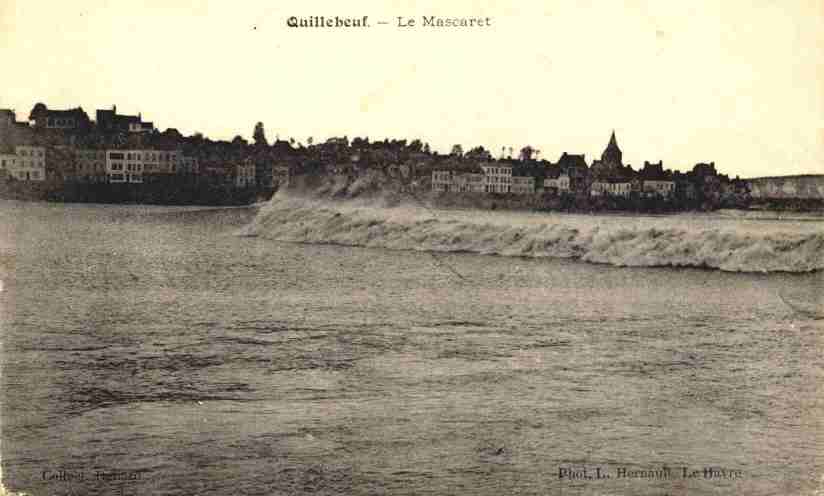 A bore is a positive surge (1)
of tidal origin. Tidal bores occur as the tidal flow turns to rising (e.g. TRICKER 1965, CHANSON 1999).
Famous ones include the Hangchow (or
Hangzhou) bore on the Qiantang river, the Amazon bore called pororoca,
the tidal bore on the Seine river, the Hoogly (or Hooghly) bore on the
Gange, the bore on the Mekong river. Smaller tidal bores occur on the Severn
river near Gloucester, England, on the Trent river (aegir), on
the Garonne and Dordogne rivers,
France, at Turnagain Arm and Knik Arm, Cook Inlet (Alaska), the bores in the
Bay of Fundy (New Brunswick, Nova Scotia) like at Petitcodiac,
tidal bores on the Styx river QLD and on the Daly river NT (Australia), the
tidal bore called benak at Batang
Lupar (Malaysia) (CHANSON 2001,2005).
A bore is a positive surge (1)
of tidal origin. Tidal bores occur as the tidal flow turns to rising (e.g. TRICKER 1965, CHANSON 1999).
Famous ones include the Hangchow (or
Hangzhou) bore on the Qiantang river, the Amazon bore called pororoca,
the tidal bore on the Seine river, the Hoogly (or Hooghly) bore on the
Gange, the bore on the Mekong river. Smaller tidal bores occur on the Severn
river near Gloucester, England, on the Trent river (aegir), on
the Garonne and Dordogne rivers,
France, at Turnagain Arm and Knik Arm, Cook Inlet (Alaska), the bores in the
Bay of Fundy (New Brunswick, Nova Scotia) like at Petitcodiac,
tidal bores on the Styx river QLD and on the Daly river NT (Australia), the
tidal bore called benak at Batang
Lupar (Malaysia) (CHANSON 2001,2005).
The front of a positive surge absorbs random disturbances on both sides
of the surge and this makes the positive surge stable and
self-perpetuating. With appropriate boundary conditions, a tidal bore may
travel long distances upsteam of the river mouth. For example, the tidal
bore on the Pungue river (Mozambique) is still about 0.7 m high about 50
km upstream of the mouth and it may reach 80 km inland.
The Mascaret of the Seine river
One of the most famous tidal bores was the mascaret of the Seine
river, France (2). A tidal bore may form for large
tidal ranges in a converging channel with a rising river bed (forming a
funnel shape). The bore occurs as the tidal flow turns to rising. The mascaret
of the Seine river had had a sinister reputation (3).
For example, 112 ships were lost between Quilleboeuf and Villequier from
1789 to 1829. In the following 21 years, another 105 ships disappeared
between Tancarville and Villequier (MALANDAIN 1988).
The height of the bore front could reach up to 7.3 m and the bore front
travelled at a celerity of about 2 to 10 m/s (BAZIN
1865, TRICKER 1965).
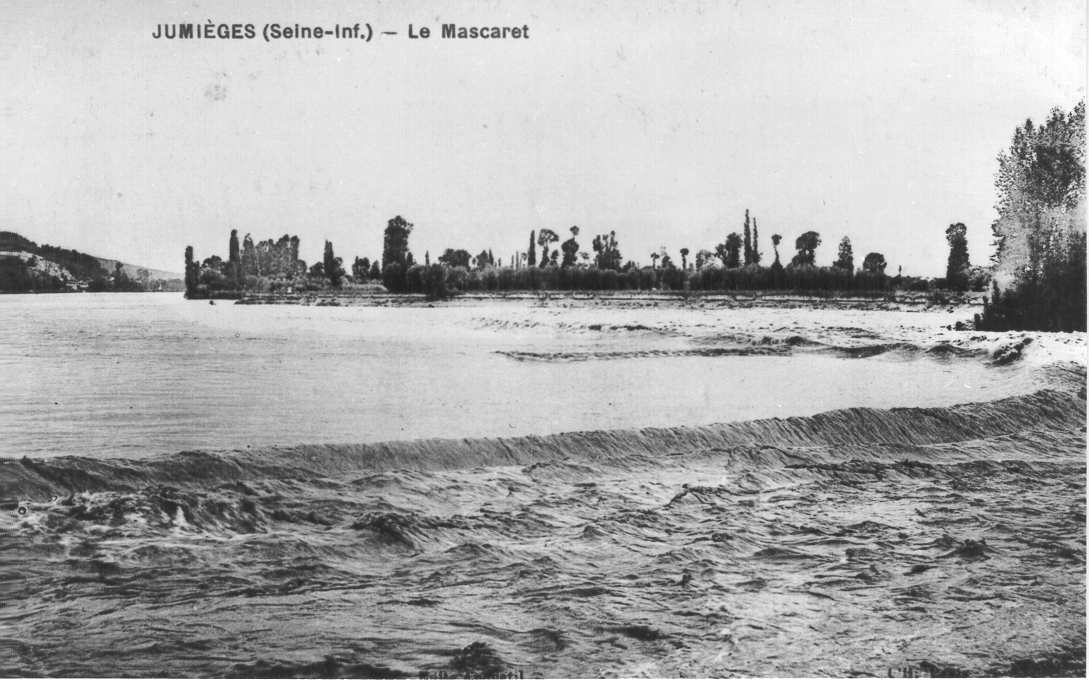
The occurrence of the mascaret was not regular. Observed
predominantly during large tides, its strength was a function of the sand
bars (near Honfleur, Hode sur la Roque, la Roque sur Nez and le Nez du
Quilleboeuf) and the bore could travel up to Rouen (nearly 80 km
upstream). Following some river training around 1845-1850, the tidal bore
disappeared until the end of 1858 when it re-appeared as strong as before.
In the 1960s, the mascaret attracted a lot of tourists during the
equinox tides, particularly at Caudebec-en-Caux where the bore amplitude
was the greatest at the time (4). The mascaret
nearly disappeared following the dredging of the Seine estuary and the new
canal de Tancarville, completed in 1963 (5).
Near the mouth of the river (e.g. at Quilleboeuf), the Seine mascaret
was a breaking bore (e.g. MALANDAIN 1988, p. 34).
Further upstream the mascaret became an undular bore in the deeper
sections of the river while a breaking front was observed near the banks.
(1) A surge is a sudden change of flow depth in an open channel (i.e. abrupt
increase or decrease in depth). An abrupt increase in flow depth is called a
positive surge while a sudden decrease in depth is termed a negative surge.
A positive surge looks like a moving hydraulic jump. Its flow properties may
be solved by applying the momentum principle to the unsteady flow based upon
a quasi-steady flow situation analogy (CHANSON 1999, pp. 67-71).
(2) The word mascaret is the French translation of tidal bore.
The front of the tidal bore was locally called 'la barre'. It is
thought that the word 'mascaret' comme from Southern France (langue d'oc).
Translations of the word tidal bore include : Tidal bore (English) =
Mascaret (French) = Pororoca (Portuguese, Brazil) = Aegir (or eagre)
(Celtic).
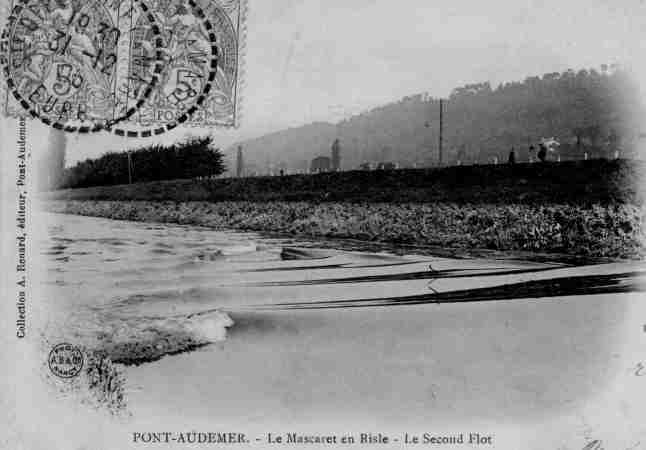
(3) In his memorable poem "A Villequier", Victor Hugo mourned the
drowning of his daughter Leopoldine and her husband in the Seine. However
Leopoldine was not drowned in a tidal bore. The day of the accident was
during neap tides and there was no "mascaret" (Maximum
tidal range for 1843). Further her husband was from a family of ship
pilots who knew well the mascaret phenomenon. For more information
see {http://www.sequana-normandie.com/}.
(4) Interestingly, the bore was the strongest near Quilleboeuf in the
1800s, at least until 1855 (MALANDAIN 1988).
Around 1895, it was the strongest between Saint-Léonard and La Mailleraye.
(5) Since 1964 the mascaret was occasionally observed, although
weaker than in the past : on 28 March 1967 between Sahurs and La Bouille
(Paris-Normandie, 29 Mar. 1967), on 7 September and 5 October 1971 at
Caudebec-en-Caux (Le-Havre-Presse, 6 Oct. 1971). In 1971, the occurrence
of the mascaret was a combination of large tides (coefficients
115-116 in October) and a lower river discharge caused by a long drought
period.
The Seine river tidal bore
Photo No. 1 : Seine river tidal bore
at Caudebec-en Caux around 1960, view from the bac (ferry) looking at the
right bank (Photograph by Raymond HUON, Courtesy of Sequana-Normandie).
Photo No. 2 : Bac de Caudebec-en Caux
facing the mascaret in 1958, view from the right bank (boats and ships had
to leave the wharf to face the mascaret in a similar way)
(Copyright: Alain HUON, Courtesy of Sequana-Normandie).
Photo No. 3 : the passage of the mascaret
in the 1930s, photograph taken at the ramp of the ferry at Yainville
(France), right bank, near the old power station (Courtesy of G. FROMAGER).
Photo No. 4 : after the passage
of the mascaret looking upsteam, view from right bank between Yainville
and Jumieges, looking toward Heurteauville; Note the quite river
upstream of the bore (on the left top) (Courtesy of Sequana-Normandie).
Photo No. 5 : the mascaret at
Aizier, near Quilleboeuf (view from left bank) (Courtesy of J.J.
MALANDAIN).
Photo No. 6 : the mascaret at
Quilleboeuf (Photo I. Hernault, Le Havre) (Courtesy of J.J. MALANDAIN).
Photo No. 7 : the mascaret at
Villequier, ancient gravure (Courtesy of J.J. MALANDAIN).
Photo No. 8 : the mascaret on the Risle,
a small tributary of the Seine river at Pont-Audemer (Collection A.
Renard, editeur, Pont-Audemer) (Courtesy of J.J. MALANDAIN).
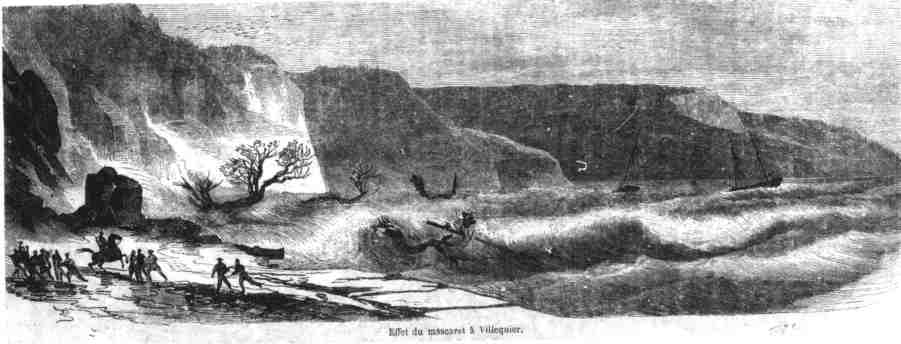
Other tidal bores
Mascaret on the Dordogne river, at Vayres (au Port de
Saint Pardon, France) : looking in the
bore direction, looking upstream
(Courtesy of Fabrice COLAS). The tidal bore (mascaret) on the 27
Sept. 2000 : Photo No. 1 :
arriving bore; Photo No. 2 : kayacks
and surfers; Photo No. 3 : close to
St Pardon; Photo No. 4 : in front of
St Pardon. Tidal bore on the Dordogne river on 21
Feb. 2004 : Photo No. 1 :
arriving bore (surge Froude number about 1.05 to 1.1) at St Pardon; Photo
No. 2 : bore moving upstream towards Vayres. Photo
No. 3 : fisherman catching lamproie fish with net few minutes prior
the bore arrival between Vayres and St Pardon. Tidal bore of the
Dordogne river on 4 July 2008 :
Photo No. 1 : view from Saint Pardon :
very weak undular surge. Photo No. 2
: looking upstream towards Vayres. Menhir
de Pierrefitte : neolithic mounument located at Chateau Saint
Martial, on the right bank next to the old Pierrefitte harbour which
serviced Saint Emilion up the 16th century. Tidal bore on 20
July 2008 at sunrise : Photo No.
1 : Dordogne river in front of Port de Saint Pardon before the tidal
bore arrival. Photo No. 2 : ripple in
the channel centreline marking the tidal bore front, view from the left
bank. Photo No. 3 : wave breaking
next to the left bank. Photo No. 4 :
whelps 60 seconds after the tidal bore front passage. Tidal bore on 21 July 2008 at sunrise : Photo
No. 1 : tidal bore front approching the jetty of Saint Pardon at
07:03. Photo No. 2 : wave breaking at
the jetty during the wave front passage. Photo
No. 3 : wave breaking on the jetty about 58 s after the tidal bore
front passage. Tidal bore on 2
September 2008 evening : Photo
No. 1: View from Port de Saint Pardon, looking downstream. Photo
No. 2 : surfers in front of Port de Saint Pardon. Photo
No. 3 : surfers on the second wave crest passing in front of Port de
Saint Pardon.
Tidal bore near Truro (Bay of
Fundy, Canada) :looking upstream,
detail of bank erosion (Courtesy of
Larry SMITH). Photo No. 3 : arriving
tidal bore on the Salmon river on 22 Sept. 2001 (Courtesy of Dr M.R.
GOURLAY). Photo No. 4 : sideview
of tidal bore on the Salmon river on 22 Sept. 2001 (Courtesy of Dr M.R.
GOURLAY)
Severn river (England) : Photo
No. 1 : at Awre where the estuary is wide and shallow (Courtesy of
Professor D.H. PEREGRINE) - Photo No. 2
: further upriver where the Severn river is deeper and narrower (Courtesy
of Professor D.H. PEREGRINE).
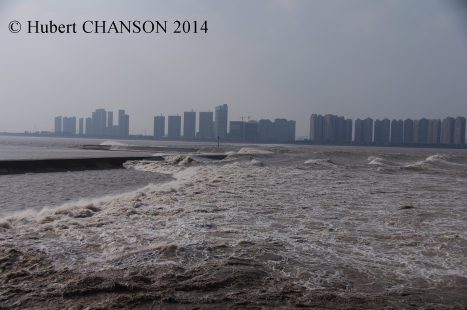 The tidal bore on
the Qiantang River near Hangzhou, China, also known as the
Hangchow or Hangzou bore: Photo
No.1: Qiantang River bore at Hangzhou CBD City Balcony on 9 October
2014. Photo No.2:
tidal bore at Qilimiao downstream of Yanguan on 11 October 2014. Photo No. 3: tidal bore between
Yanguan and Laoyanchang on 11 October 2014. Photo
No. 4: breaking tidal bore and roller between between Yanguan and
Laoyanchang on 11 October 2011. Photo
No.
5: tidal bore reflection at Laoyanchang on 11 October 2011. Photo No. 6 : tidal bore impact on
sluice gate structure at Jiuxi on 11 October 2014; in the foreground, the
reflected wave overtopped the river bank, flooding the nearby arterial and
causing some traffic accident and traffic jam. Photo
No. 7: tidal bore at Meilvba overtopping a spur dyke on 12 October
2014. Photo No. 8:
tidal bore impact on the sea wall at Xinchang on 13 October 2014; the bore
was reflected on the wall and the reflection came back about 40 minutes
later. Photo No. 9:
tidal bore warning sign at Meilvba in October 2014; in this area, the
embankent dyke is regularly overtopped. Photo
No. 11 : view from the left bank (Courtesy of Dr J. Eric JONES); Photo No. 12 : another detailed view
(Courtesy of Dr J. Eric JONES).
The tidal bore on
the Qiantang River near Hangzhou, China, also known as the
Hangchow or Hangzou bore: Photo
No.1: Qiantang River bore at Hangzhou CBD City Balcony on 9 October
2014. Photo No.2:
tidal bore at Qilimiao downstream of Yanguan on 11 October 2014. Photo No. 3: tidal bore between
Yanguan and Laoyanchang on 11 October 2014. Photo
No. 4: breaking tidal bore and roller between between Yanguan and
Laoyanchang on 11 October 2011. Photo
No.
5: tidal bore reflection at Laoyanchang on 11 October 2011. Photo No. 6 : tidal bore impact on
sluice gate structure at Jiuxi on 11 October 2014; in the foreground, the
reflected wave overtopped the river bank, flooding the nearby arterial and
causing some traffic accident and traffic jam. Photo
No. 7: tidal bore at Meilvba overtopping a spur dyke on 12 October
2014. Photo No. 8:
tidal bore impact on the sea wall at Xinchang on 13 October 2014; the bore
was reflected on the wall and the reflection came back about 40 minutes
later. Photo No. 9:
tidal bore warning sign at Meilvba in October 2014; in this area, the
embankent dyke is regularly overtopped. Photo
No. 11 : view from the left bank (Courtesy of Dr J. Eric JONES); Photo No. 12 : another detailed view
(Courtesy of Dr J. Eric JONES).
The tidal bore of the Petitcodiac river,
near Moncton (Bay of Fundy, Canada). Photo
No.
1 : in spring 1908? near Moncton, the bore height being about 1 to
1.5 m (Courtesy of the Petitcodiac Riverkeeper) - Photo
No. 2 : on 23 Mar. 2000, the bore height was estimated to be about
0.5 m. The river discharge was larger than usual because of snow melt
(Courtesy of the Petitcodiac Riverkeeper).
Tidal bore on the Couesnon river
(France). The tidal bore is significantly weaker since the construction of
an upstream barrage. Photo No. 1 :
approaching bore on 7 March 2004 around 18:20. Photo
No. 2 : bore seen from the Tour de Gabriel on 7 March 2004 (bore
flowing from right to left). Photo No. 3
: Couesnon river at low tide on 4 Feb. 2004, looking upstream from Mont
Saint Michel monastery.
Tidal bore of the Sélune river,
Baie du Mont Saint Michel (France). Tidal bore on 7
April 2004 : tidal range = 13.75 m (highest tidal range for 2004).
Photo No. 1 : Sélune river estuary,
viewed from left bank at Roche-Torin at sunrise on 7/4/04 beofre tidal bore
arrival. Photo No. 2 : tidal bore seen
from Roche-Torin far away in front of Ile de Tombelaine with seagulls (white
dots) in front of the bore. Photo No. 3
: advancing tidal bore in front of Pointe du Grouin du Sud. Photo
No.
4 : advancing bore front viewed from Roche-Torin on 7/4/04. Photo
No. 5 : advancing bore front viewed from Roche-Torin on 7/4/04. Photo
No. 6 : advancing bore front just in front of Roche-Torin on 7/4/04. Photo No. 7 : tidal bore advancing
upstream, seen from Roche-Torin on 7/4/04. Photo
No. 8 : approaching tidal bore, one hour later, upstream of Pont
Aubaud (15th century bridge) at Pontaubault on7/4/04. Photo
No. 9 : approaching tidal bore, one hour later, upstream of Pont
Aubaud (15th century bridge) at Pontaubault on7/4/04. Photo
No.
10 : Sélune river tidal bore approaching Pont Aubaud (15th century
bridge) at Pontaubault on7/4/04. Photo No.
11 : Sélune river tidal bore passing below Pont Aubaud (15th century
bridge) at Pontaubault on7/4/04; note the bridge pier "knife" shape; note
also that the bore became an undular bore just downstream of the bridge,
possibly because of a local scour hole. Photo
No. 12 : strong current below Pont Aubaud (15th century bridge) on
7/4/04 after the tidal bore passage, view from left bank looking upstream.
Tidal bore on 2 August 2008: tidal
range = 12.65 m. Photo No. 1 : Sélune
river tidal bore at Roche Torin on 2/8/08 at sunset, viewed from the left
bank (bore propagation from left to right). Photo
No. 2 : tidal bore propagation past Roche Torin on 2/8/08. Photo
No. 3 : tidal bore past Roche Torin on 2/8/08. Photo
No. 4 : Sélune river tidal bore at Pontaubault on 2/8/08 at sunset,
about 1 hour after flowing past Roche Torin. Photo
No. 5 : Sélune river tidal bore at Pontaubault on 2/8/08, approaching
the histoical Pont Aubaud (15th century bridge); note the undular nature of
the tidal bore and the whelps (éteules). Photo
No. 6 : interactions of the whelps (éteules) with the bridge piers
shortly after the tidal bore front passage on 2/8/08. Tidal bore on 3
August 2008: tidal range = 12.65 m. Photo
No. 1 : Sélune river tidal bore at Roche Torin on 3/8/08 shortly after
sunrise, viewed from the left bank (bore propagation from left to right). Photo No. 2 : tidal bore propagation at
Roche Torin on 3/8/08.
Read Coastal
Observations:
The Tidal Bore of the Sélune River, Baie du Mont Saint Michel, France
(Shore & Beach, 2004, Vol. 72,
No. 4, pp. 14-16)
Tidal bore of the Garonne river,
France. Tidal bore on 5 July 2008
at Arcins (Latresnes). Photo No. 1 :
tidal bore entering the Arcins channel. Photo
No. 2 : incoming undular bore in the Arcins channel around 6:20am
looking downstream. Photo No. 3 :
whelps (eteules) behind the bore front shaking the pontoon and jetty. Tidal
bore on 5 July 2008 at Langoiran. Photo No.
1 : very weak bore with some was breaking next to the left bank about
7:05am, while there was no bore in the main channel nor next to the right
bank. Tidal bore on 6 July 2008 at
Arcins (Latresnes). Photo No. 1 :
looking downstream at the incoming bore around 7:10am; note the small ripple
formed by the tidal bore. Photo No. 2 :
undular bore passing in front of the photographer. Photo
No. 3 : propagating bore; note the strong mixing and reflection in the
inlet in the foreground. Tidal bore on 19
July 2008 at Podensac.Photo No. 1
: large-scale vortical structures at the free-surface on the channel
centreline on 19 July 2008 at end of ebb tide flow (18:30) shortly before
tidal bore arrival. Photo No. 2 : tidal
bore propagation next to left bank looking dowsntream at 18:43. Photo
No. 3 : details of the bore front impact on the left bank. Tidal bore
on 20 July 2008 at Langoiran. Photo No. 1 : surfer riding the bore
front next to the left bank. Photo No. 2
: surfer getting back to the boat after the ride. Tidal bore on 2 September 2008 at Podensac. Photo
No. 1 : Advancing bore with surfers. Photo
No. 2 : surfers next to the left bank. Tidal bore on 3
September 2008 at Baurech. Photographs taken from a kayack surfing
the Garonne River bore. Photo No. 1 :
looking towards the left bank while riding ahead of the first wave crest. Photo No. 2 : looking towards the right
bank at several kayacks riding ahead the first wave crest. Photo
No. 3 : riding the whelps behind the bore front.
Tidal bores in Bretagne (Brittany),
France. (1) Tidal bore of the Arguenon
River, Bretagne (Brittany). Photo
No. 1 : tidal bore at Les Pierre Sonantes, le Guildo on 15 Oct. 2008.
Photo No. 2 : tidal bore betwen Le
Guildo and Créhen. (2) Tidal bore of the Frémur
Creek, Côtes d'Armor, Bretagne (Brittany). Photo
No. 1 : tidal bore at Port-à-la Duc on 15 Oct. 2008. Photo
No. 2 : tidal bore upstream of Port-à-la Duc on 16 Oct. 2008.
Related
links
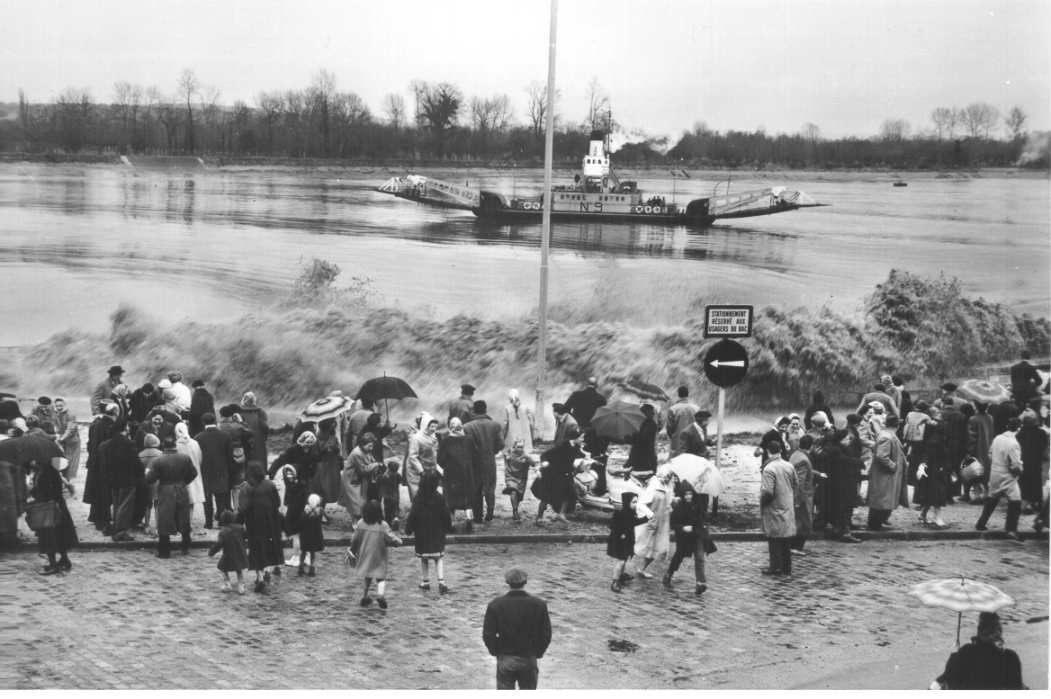
References
BAZIN, H. (1865). "Recherches Expérimentales sur la Propagation des
Ondes." ('Experimental Research on Wave Propagation.') Mémoires
présentés par divers savants à l'Académie des Sciences, Paris,
France, Vol. 19, pp. 495-644 (in French).
CHANSON, H. (1999). "The Hydraulics of Open
Channel Flows : An Introduction." Butterworth-Heinemann,
London, UK, 512 pages (ISBN 0 340 74067 1).
CHANSON, H. (2001). "The Role of Environmental Fluid Mechanics in
Water System Management." Proc. 1st Intl Conf International Federation for
Environmental Management System IFEMS'01, 30 Jan.-2 Feb., Tsurugi, Japan,
Keynote lecture. (download PREPRINT)
CHANSON, H. (2001). "Flow Field in a Tidal
Bore : a Physical Model."
Proc. 29th
IAHR Congress, Beijing, China, Theme E, Tsinghua University
Press, Beijing, G. LI Ed., pp. 365-373 (ISBN 7-302-04676-X/TV). (CD-ROM,
Tsinghua University Press, ISBN 7-900637-10-9.) (download
PDF
file)
CHANSON, H. (2003). "Mixing and Dispersion in Tidal Bores. A Review."
Proc. Intl Conf. on Estuaries & Coasts
ICEC 2003, Hangzhou, China, Nov. 8-11, Intl Research &
Training Center on Erosion & Sedimentation Ed., Vol. 2, pp. 763-769
(ISBN 7 900 662 67 7/G.79). (Download
PDF
File)
CHANSON, H. (2005). "Mascaret, Aegir,
Pororoca, Tidal Bore. Quid ? Où? Quand? Comment? Pourquoi ?"
Jl
La Houille Blanche, No. 3, pp. 103-114 (ISSN 0018-6368) (in
French). (Download
PDF file)
DONNELLY, C., and CHANSON, H. (2002). "Environmental impact of a Tidal
Bore on Tropical Rivers."
Proc. 5th
Intl River Management Symp., Brisbane, Australia, Sept., 3-6, 9
pages. (Download
PDF File)
MALANDAIN, J.J. (1988). "La Seine au Temps du Mascaret." ('The Seine River
at the Time of the Mascaret.')
Le
Chasse-Marée, No. 34, pp. 30-45 (in French).
TRICKER, R.A.R. (1965). "Bores, Breakers, Waves and Wakes."
American
Elsevier
Publ. Co., New York, USA.
Bibliography
BARTSCH-WINKLER, S., and LYNCH, D.K. (1988).
"Catalog of Worldwide Tidal Bore Occurrences and Characteristics."
US Geological Survey Circular, No.
1022, 17 pages.
BAZIN, H. (1865). "Recherches Expérimentales sur la Propagation des
Ondes." ('Experimental Research on Wave Propagation.')
Mémoires
présentés par divers savants à
l'Académie des Sciences, Paris, France, Vol. 19, pp. 495-644 (in
French).
CHANSON, H. (2004). "
Environmental
Hydraulics of Open Channel Flows."
Elsevier
Butterworth-Heinemann, Oxford, UK (ISBN 0 7506 6165 8).
CHANSON, H. (2004). "
The
Hydraulics of Open Channel Flows : An Introduction."
Butterworth-Heinemann, 2nd
edition, Oxford, UK (ISBN 0 7506 5978 5).
CHANSON, H. (2004). "Mixing and Dispersion Role of Tidal Bores." in "
Fluvial, Environmental & Coastal
Developments in Hydraulic Engineering",
Balkema, Leiden, The
Netherlands, Proc. Intl Workshop on State-of-the-Art Hydraulic
Engineering, 16-19 Feb. 2004, Bari, Italy, M. MOSSA, Y. YASUDA and H.
CHANSON Ed., pp. 223-232 (ISBN 04 1535 899 X). (
Download
PDF file) (
Leaflet
and Order Form)
CHANSON, H. (2004). "Coastal Observations: The Tidal Bore of the Sélune
River, Baie du Mont Saint Michel, France."
Shore
& Beach, Vol. 72, No. 4, pp. 14-16 (ISSN 0037-4237). (
Download
PDF file)
CHANSON, H. (2005). "Physical Modelling of the Flow Field in an Undular
Tidal Bore."
Jl of Hyd. Res.,
IAHR, Vol. 43, No. 3, pp. 234-244 (ISSN 0022-1686). (
Download
PDF file)
CHANSON, H. (2008). "Turbulence in Positive Surges and Tidal Bores.
Effects of Bed Roughness and Adverse Bed Slopes."
Hydraulic
Model Report No. CH68/08, Div. of Civil Engineering, The
University of Queensland, Brisbane, Australia, 121 pages & 5 movie
files (ISBN 9781864999198). (
PDF
file
at UQeSpace) (Movie files at
UQeSpace)
CHANSON, H. (2008). "Photographic Observations of Tidal Bores (Mascarets)
in France." Hydraulic Model Report No. CH71/08, Div. of Civil Engineering,
The University of Queensland, Brisbane, Australia, 104 pages, 1 movie and
2 audio files (ISBN 9781864999303). (
PDF
file at UQeSpace) (
Movie
file
and sound audio files at UQeSpace)
CHANSON, H. (2009). "The Rumble Sound Generated by a Tidal Bore Event in
the Baie du Mont Saint Michel."
Journal
of the Acoustical Society of America, Vol. 125, No. 6, pp.
3561-3568 (DOI: 10.1121/1.3124781) (ISSN 00014966). (
PDF
file) (
PDF
file
at UQeSpace) Digital appendix: (
.WAV
file at UQeSpace). Data set:
UQeSpace
data collection.
CHANSON, H. (2009). "An Experimental Study of Tidal Bore Propagation: the
Impact of Bridge Piers and Channel Constriction."
Hydraulic
Model Report No. CH74/08, School of Civil Engineering, The
University of Queensland, Brisbane, Australia, 110 pages & 5 movies
(ISBN 9781864999600). (
PDF
file at UQeSpace) (
Movies
at
UQeSpace)
CHANSON, H. (2010). "Unsteady Turbulence in Tidal Bores: Effects of Bed
Roughness."
Journal of Waterway, Port,
Coastal, and Ocean Engineering, ASCE, Vol. 136, No. 5, pp.
247-256 (DOI: 10.1061/(ASCE)WW.1943-5460.0000048) (ISSN 0733-950X). (
PDF file) (
Record
at UQeSpace)
CHANSON, H. (2011). "Current Knowledge in Tidal bores and their
Environmental, Ecological and Cultural Impacts."
Environmental
Fluid Mechanics, Vol. 11, No. 1, pp. 77-98 (DOI:
10.1007/s10652-009-9160-5) (ISSN 1567-7419 [Print] 1573-1510 [Online]). (
PDF file) (
Record at UQeSpace)
CHANSON, H. (2012). "Momentum Considerations in Hydraulic Jumps and
Bores."
Journal of Irrigation and
Drainage Engineering, ASCE, Vol. 138, No. 4, pp. 382-385 (DOI
10.1061/(ASCE)IR.1943-4774.0000409) (ISSN 0733-9437). (
Postprint at
UQeSpace) (
PDF
file)
CHANSON, H., and TAN, K.K. (2010). "Turbulent Mixing of Particles under
Tidal Bores: an Experimental Analysis."
Journal
of Hydraulic Research, IAHR, Vol. 48, No. 5, pp. 641-649 (DOI:
10.1080/00221686.2010.512779 (ISSN 0022-1686). (
PDF
file at UQeSpace)
CHANSON, H., and TAN, K.K. (2011). "Turbulent Dispersion of Fish Eggs
under Tidal Bores."
Fluid Dynamics
& Materials Processing, Tech Science Press, Vol. 7, No. 4,
pp. 403-418 (DOI: 10.3970/fdmp.2011.007.403) (ISSN 1555-256X (Printed);
1555-2578 (Electronic)). (
Postprint
at UQeSpace) (
PDF
file)
CHANSON, H. (2011). "Current Knowledge in Tidal bores and their
Environmental, Ecological and Cultural Impacts."
Environmental
Fluid Mechanics, Vol. 11, No. 1, pp. 77-98 (DOI:
10.1007/s10652-009-9160-5) (ISSN 1567-7419 [Print] 1573-1510 [Online]). (
PDF file) (
Record at UQeSpace)
CHANSON, H. (2011). "Turbulent Shear Stresses in Hydraulic Jumps and
Decelerating Surges: An Experimental Study."
Earth
Surface Processes and Landforms, Vol. 36, No. 2, pp. 180-189
& 2 videos (DOI: 10.1002/esp.2031 ) (ISSN 0197-9337). (
PDF file) (
Record
at UQeSpace)
CHANSON, H. (2011). "
Tidal
Bores, Aegir, Eagre, Mascaret, Pororoca: Theory and Observations."
World Scientific, Singapore, 220
pages (ISBN 9789814335416).
CHANSON, H. (2013). "Tidal Bore Research: Field Works, Physical Modeling,
CFD & More."
Proc. 35th IAHR World
Congress, Chengdu, China, 8-13 Sept., WANG Z., LEE, J.H.W., GAO,
J., and CAO S. Editors, Invited lecture, Paper A12210, 11 pages (ISBN
978-7-302-33544-3). (
PDF
file) (
Record
at UQeSpace)
CHANSON, H. (2016). "Atmospheric Noise of a Breaking Tidal Bore."
Journal
of the Acoustical Society of America, Vol. 139, No. 1, pp. 12-20
(DOI: 10.1121/1.4939113) (ISSN 00014966). (
PDF
file) (
Preprint
at UQeSpace)
CHANSON, H., and DOCHERTY, N.J. (2012). "Turbulent Velocity Measurements
in Open Channel Bores."
European
Journal of Mechanics B/Fluids, Vol. 32, pp. 52-58 (DOI
10.1016/j.euromechflu.2011.10.001) (ISSN 0997-7546). (
Postprint
at UQeSpace) (
PDF
file)
CHANSON, H., LUBIN, P., and GLOCKNER, S. (2012). "Unsteady Turbulence in a
Shock: Physical and Numerical Modelling in Tidal Bores and Hydraulic
Jumps." in "
Turbulence: Theory,
Types and Simulation",
Nova
Science Publishers, Hauppauge NY, USA, Ed. R.J. MARCUSO, Chapter
3, pp. 113-148 (ISBN 978-1-61761-735-5). (
PDF
file) (
Record
at UQeSpace)
CHANSON, H., LUBIN, P., SIMON, B., and REUNGOAT, D. (2010). "Turbulence
and Sediment Processes in the Tidal Bore of the Garonne River: First
Observations."
Hydraulic Model Report
No. CH79/10, School of Civil Engineering, The University of
Queensland, Brisbane, Australia, 97 pages (ISBN 9781742720104). (
PDF file at
UQeSpace)
CHANSON, H., REUNGOAT, D., SIMON, B., and LUBIN, P. (2011).
"High-Frequency Turbulence and Suspended Sediment Concentration
Measurements in the Garonne River Tidal Bore."
Estuarine
Coastal and Shelf Science, Vol. 95, No. 2-3, pp. 298-306 (DOI
10.1016/j.ecss.2011.09.012) (ISSN 0272-7714). (
PDF
file at UQeSpace) (
PDF
file)
CHANSON, H., and TOI, Y.H. (2013). "Breaking tidal bore: comparison
between field data and laboratory experiments."
Proc.
21ème Congrès Français de Mécanique CFM 2013, Bordeaux, France,
26-30 Aug., Paper R3SJ46ER, 6 pages (USB) (in English). (
PDF
file) (
Record
at UQeSpace)
CHANSON, H., and TOI, Y.H. (2015). "Physical Modelling of Breaking Tidal
Bores: Comparison with Prototype Data."
Journal
of
Hydraulic Research, IAHR, Vol. 53, No. 2, pp. 264-273 (DOI:
10.1080/00221686.2014.989458) (ISSN 0022-1686). (
Postprint
at UQeSpace) (
PDF
file)
DOCHERTY, N.J., and CHANSON, H. (2012). "Physical Modelling of Unsteady
Turbulence in Breaking Tidal Bores."
Journal
of Hydraulic Engineering, ASCE, Vol. 138, No. 5, pp. 412-419
(DOI: 10.1061/(ASCE)HY.1943-7900.0000542) (ISSN 0733-9429). (
Postprint at
UQeSpace) (
PDF
file)
DONNELLY, C., and CHANSON, H. (2005). "Environmental Impact of Undular
Tidal Bores in Tropical Rivers."
Environmental
Fluid
Mechanics, Vol. 5, No. 5, pp. 481-494 (ISSN 1567-7419). (
PDF
file at UQeSpace) (
Download
PDF file)
FAVRE, H. (1935). "Etude Théorique et Expérimentale des Ondes de
Translation dans les Canaux Découverts." ('Theoretical and Experimental
Study of Travelling Surges in Open Channels.')
Dunod,
Paris, France (in French).
FERNANDO, R., LENG, X., and CHANSON, H. (2020). "On Unsteady Velocity
Measurements and Profiling in Compression Waves in an Asymmetrical
Trapezoidal Channel."
Experimental Thermal and Fluid Science, Vol.
112, Paper 109986, 15 pages & 8 video movies (DOI:
10.1016/j.expthermflusci.2019.109986) (ISSN 0894-1777). (
PDF file) (
Postprint at
UQeSpace) (
Video
movies at UQeSpace)
FURGEROT, L. (2014). "Propriétés hydrodynamiques du mascaret et de son
influence sur la dynamique sédimentaire. Une approche couplée en canal et
in situ (estuaire de la Sée, Baie du Mont Saint Michel)." (Hydrodynamic
characteristics of tidal bores and impact on sedimentary processes. A
combination of laboratory experimenta and field studies (Sée estuary, Bay
of Mont Saint Michel).')
Ph.D. thesis,
University of Caen Basse-Normandie, laboratory M2C, Caen, France, 386
pages.
KEEVIL, C.E., CHANSON, H., and REUNGOAT, D. (2015)." Fluid Flow and
Sediment Entrainment in the Garonne River Bore and Tidal Bore Collision."
Earth Surface Processes and Landforms,
Vol. 40, No. 12, pp. 1574-1586 (DOI: 10.1002/esp.3735) (ISSN 0197-9337). (
PDF file)
(
Preprint
at
UQeSpace)
KHEZRI, N. (2014). "Modelling Turbulent Mixing and Sediment Process
Beneath Tidal Bores: Physical and Numerical Investigations."
Ph.D.
thesis, School of Civil Engineering, The University of
Queensland, Brisbane, Australia, 267 pages. (
PDF
file at UQeSpace)
KHEZRI, N., and CHANSON, H. (2012). "Inception of Bed Load Motion beneath
a Bore."
Geomorphology, Vol.
153-154, pp. 39-47 (DOI: 10.1016/j.geomorph.2012.02.006) (ISSN 0169-555X).
(
Postprint
at UQeSpace) (
PDF
file)
KHEZRI, N., and CHANSON, H. (2012). "Sediment Inception under Breaking
Tidal Bores."
Mechanics Research
Communications, Vol. 41, pp. 49-53 (DOI
10.1016/j.mechrescom.2012.02.010) (ISSN 0093-6413). (
PDF
file) (
Postprint
at UQeSpace) (
Digital
appendix:
video movie)
KHEZRI, N., and CHANSON, H. (2012). "Undular and Breaking Tidal Bores on
Fixed and Movable Gravel Beds."
Journal
of Hydraulic Research, IAHR, Vol. 50, No. 4, pp. 353-363 (DOI:
10.1080/00221686.2012.686200) (ISSN 0022-1686). (
Postprint
at UQeSpace) (
PDF
file)
KHEZRI, N., and CHANSON, H. (2013). "Simultaneous Measurements of
Turbulent Velocity and Sediment Motion under Tidal Bores." Proc. 35th IAHR
World Congress, Chengdu, China, 8-13 Sept., WANG Z., LEE, J.H.W., GAO, J.,
and CAO S. Editors, Paper A10216, 10 pages (ISBN 978-7-302-33544-3). (
PDF file) (
Record
at UQeSpace)
KIRI, U., LENG, X., and CHANSON, H. (2018). "Positive Surge Propagation in
a Non-Rectangular Asymmetrical Channel."
Hydraulic Model Report No.
CH110/18, School of Civil Engineering, The University of Queensland,
Brisbane, Australia, 159 pages and 2 digital appendices incl. 5 movies
(ISBN 978-1-74272-196-5). (
PDF
file at UQeSpace) (
Digital
Appendices and Movies at UQeSpace)
KIRI, U., LENG, X., and CHANSON, H. (2020). "Positive Surge Propagating in
an Asymmetrical Canal."
Journal of Hydro-environment Research,
IAHR, Vol. 31, pp. 41-47 &
Supplementary material incl. 4 video movies (DOI:
10.1016/j.jher.2020.04.002) (ISSN 1570-6443). (
PDF
file) (
Preprint
at UQeSpace) (
Movies
at UQeSpace)
KIRI, U., LENG, X., and CHANSON, H. (2020). "Transient Secondary Currents
behind a Compression Wave in an Irregular Channel."
Environmental
Fluid Mechanics, Vol. 20, No. 4, pp. 1053-1073 & 1 vide movie
(DOI: 10.1007/s10652-020-09740-y) (ISSN 1567-7419 [Print] 1573-1510
[Online]). (
PDF
file) (
Postprint
at UQeSpace) (
Movie
at UQeSpace)
KOCH, C., and CHANSON, H. (2005). "An Experimental Study of Tidal Bores
and Positive Surges: Hydrodynamics and Turbulence of the Bore Front."
Report No. CH56/05, Dept. of Civil
Engineering, The University of Queensland, Brisbane, Australia, July, 170
pages (ISBN 1864998245). (
Download PDF file)
(also
PDF Version at
EprintsUQ)
KOCH, C., and CHANSON, H. (2006). "Unsteady Turbulence Characteristics in
an Undular Bore."
Proc. International
Conference on Fluvial Hydraulics River Flow 2006, Lisbon,
Portugal, 6-8 Sept., Topic A1, R.M.L. FERREIRA, E.C.T.L. ALVES, J.G.A.B.
LEAL, and A.H. CARDOSO Eds., Balkema Publ., Taylor & Francis Group,
London, Vol. 1, pp. 79-88 (ISBN 0 415 40815 6). (
PDF
version at EprintsUQ) (
Preprint)
KOCH, C., and CHANSON, H. (2008). "Turbulent Mixing beneath an Undular
Bore Front."
Journal of Coastal
Research, Vol. 24, No. 4, pp. 999-1007 (DOI: 10.2112/06-0688.1)
(ISSN 0749-0208). (
PDF
file at UQeSpace)
KOCH, C., and CHANSON, H. (2009). "Turbulence Measurements in Positive
Surges and Bores."
Journal of Hydraulic
Research, IAHR, Vol. 47, No. 1, pp. 29-40 (DOI:
10.3826/jhr.2009.2954) (ISSN 0022-1686). (
PDF
file at UQeSpace)
LENG, X. (2018). "A Study of Turbulence: the Unsteady Propagation of Bores
and Surges."
Ph.D. thesis, School of Civil Engineering, The
University of Queensland, Brisbane, Australia, 364 pages & 2 Digital
Appendices (
DOI:
10.14264/uql.2018.501). (
PDF
at UQeSpace) (
Digital
Appendix E &
Digital
Appendix F)
LENG, X., and CHANSON, H. (2015). "Breaking Bore: Physical Observations of
Roller Characteristics."
Mechanics
Research Communications, Vol. 65, pp. 24-29 (DOI:
10.1016/j.mechrescom.2015.02.008) (ISSN 0093-6413). (
PDF
file) (
Preprint
at
UQeSpace)
LENG, X., and CHANSON, H. (2015). "Unsteady Turbulence during the Upstream
Propagation of Undular and Breaking Tidal Bores: an Experimental
Investigation."
Hydraulic Model Report
No. CH98/15, School of Civil Engineering, The University of
Queensland, Brisbane, Australia, 235 pages & 4 video movies (ISBN 978
1 74272 135 4). (
PDF
file at UQeSpace) (
Video
movies at UQeSpace)
LENG, X., and CHANSON, H. (2015). "Turbulent Advances of a Breaking Bore:
Preliminary Physical Experiments."
Experimental
Thermal and Fluid Science, Vol. 62, pp. 70-77 (DOI:
10.1016/j.expthermflusci.2014.12.002) (ISSN 0894-1777). (
PDF file) (
Record at UQeSpace)
LENG, X., and CHANSON, H. (2016). "Coupling between Free-surface
Fluctuations, Velocity Fluctuations and Turbulent Reynolds Stresses during
the Upstream Propagation of Positive Surges, Bores and Compression Waves."
Environmental Fluid Mechanics,
Vol. 16, No. 4, pp. 695-719 & digital appendix (DOI:
10.1007/s10652-015-9438-8) (ISSN 1567-7419 [Print] 1573-1510 [Online]). (
PDF file)
(
Digital
appendix) (
Reprint
at UQeSpace)
LENG, X., and CHANSON, H. (2019). "Two-Dimensional Integral Turbulent
Scales in Compression Wave in a Canal."
Experimental Thermal and Fluid
Science, Vol. 102, pp. 163-180 (DOI:
10.1016/j.expthermflusci.2018.09.014) (ISSN 0894-1777). (
PDF file) (
Deposit at
UQeSpace)
LENG, X., and CHANSON, H. (2019). "Air-Water Interaction and
Characteristics in Breaking Bores."
International Journal of
Multiphase Flow, Vol. 120, Paper 103101, 17 pages (DOI:
10.1016/j.ijmultiphaseflow.2019.103101) (ISSN 0301-9322). (
PDF file) (
Postprint at
UQeSpace)
LENG, X., CHANSON, H., and REUNGOAT, D. (2018). "Turbulence and Turbulent
Flux Events in Tidal Bores: Case Study of the Undular Tidal Bore of the
Garonne River."
Environmental Fluid Mechanics, Vol. 18, No. 4, pp.
807-828 (DOI: 10.1007/s10652-017-9561-9) (ISSN 1567-7419 [Print] 1573-1510
[Online]). (
PDF
file) (
Preprint
at UQeSpace)
LENG, X., SIMON, B., KHEZRI, N., LUBIN, P., and CHANSON, H. (2018). "CFD
Modelling of Tidal Bores: Development and Validation Challenges."
Coastal Engineering Journal, Vol. 60, No. 4, pp. 423-436 (DOI:
10.1080/21664250.2018.1498211) (ISSN 0578-5634). (
PDF
file) (
Deposit
at UQeSpace)
LENG, X., LUBIN, P., and CHANSON, H. (2020).
"CFD modelling of surface wave breaking in a long channel."
Proceedings
of 22nd Australasian Fluid Mechanics Conference AFMC2020, Brisbane,
Australia, 7-10 December, Published by The University of Queensland,
Editors H. CHANSON and R. BROWN,
Invited plenary lecture paper,
Paper 229, 4 pages (DOI: 10.14264/852394c) (ISBN 978-1-74272-341-9). (
Deposit at UQeSpace)
LI, Y. (2020). "Hydrodynamics of tidal
bores: turbulent propagation and sediment transport."
Ph.D. Thesis,
The University of Queensland, School of Civil Engineering, Brisbane,
Australia, 308 pages & Supplementary materials (DOI:
10.14264/uql.2020.671). (
Deposit
at UQeSpace)
LI, Y., and CHANSON, H. (2018). "Decelerating Bores in Channels and
Estuaries."
Coastal Engineering Journal, Vol. 60, No. 4, pp.
449-465 (DOI: 10.1080/21664250.2018.1529261) (ISSN 0578-5634). (
PDF file) (
Deposit at
UQeSpace)
LI, Y., PAN, D.Z., CHANSON, H., and PAN, C.H. (2019). "Real-Time
Characteristics of Tidal Bore Propagation in the Qiantang River Estuary,
China, Recorded by Marine Radar."
Continental Shelf Research, Vol.
180, pp. 48-58 (DOI: 10.1016/j.csr.2019.04.012) (ISSN 0278-4343). (
PDF file) (
Record at
UQeSpace)
LUBIN, P., GLOCKNER, S., and CHANSON, H. (2010). "Numerical Simulation of
a Weak Breaking Tidal Bore."
Mechanics
Research Communications, Vol. 37, No. 1, pp. 119-121 (DOI:
10.1016/j.mechrescom.2009.09.008) (ISSN 0093-6413). (
PDF
file at UQeSpace)
MONTES, J.S. (1979). "Undular Hydraulic Jump - Discussion."
Jl of Hyd. Div., ASCE, Vol. 105, No. HY9, pp. 1208-1211.
MONTES, J.S. (1986). "A Study of the Undular Jump Profile."
Proc.
9th
Australasian Fluid Mechanics Conference AFMC, Auckland, New
Zealand, pp. 148-151.
MONTES, J.S., and CHANSON, H. (1998). "Characteristics of Undular
Hydraulic Jumps. Results and Calculations."
Jl of Hyd. Engrg.,
ASCE, Vol. 124, No. 2, pp. 192-205 (ISSN 0733-9429). (
download
PDF file)
MOUAZE, D., CHANSON, H., and SIMON, B. (2010). "Field Measurements in the
Tidal Bore of the Sélune River in the Bay of Mont Saint Michel (September
2010)."
Hydraulic Model Report No.
CH81/10, School of Civil Engineering, The University of
Queensland, Brisbane, Australia, 72 pages (ISBN 9781742720210). (
PDF file at
UQeSpace)
PAN, D.Z., and CHANSON, H. (2015). "Physical Modelling of Tidal Bore Dyke
Overtopping: Implication on Individuals' Safety."
Proc.
36th IAHR World Congress, The Hague, The Netherlands, 27 June-3
July, Paper 78972, 8 pages (ISBN 978-90-824846-0-1). (
PDF
file)
PEREGRINE, D.H. (1966). "Calculations of the Development of an Undular
Bore."
Jl Fluid Mech., Vol. 25,
Part 2, pp. 321-330.
REUNGOAT, D., CHANSON, H., and CAPLAIN, B. (2012). "Field Measurements in
the Tidal Bore of the Garonne River at Arcins (June 2012)."
Hydraulic
Model Report No. CH89/12, School of Civil Engineering, The
University of Queensland, Brisbane, Australia, 121 pages (ISBN
9781742720616). (
PDF
file at UQeSpace)
REUNGOAT, F., CAPLAIN, B., and CHANSON, H. (2013). "Field Measurements in
the Tidal Bore of the Garonne River after a Recent Flood."
Proc.
Coastal Dynamics 2013, Arcachon, France, 24-28 June, pp.
1309-1318. (
Record
at UQeSpace) (
PDF
file)
REUNGOAT, D., CHANSON, H., and CAPLAIN, B. (2014). "Sediment Processes and
Flow Reversal in the Undular Tidal Bore of the Garonne River (France)."
Environmental Fluid Mechanics, Vol.
14, No. 3, pp. 591–616 (DOI: 10.1007/s10652-013-9319-y) (ISSN 1567-7419
[Print] 1573-1510 [Online]). (
Postprint
at UQeSpace) (
PDF
file)
REUNGOAT, D., CHANSON, H., and KEEVIL, C.E. (2014). "Turbulence,
Sedimentary Processes and Tidal Bore Collision in the Arcins Channel,
Garonne River (October 2013)."
Hydraulic
Model Report No. CH94/14, School of Civil Engineering, The
University of Queensland, Brisbane, Australia, 145 pages (ISBN
9781742721033). (
PDF
file at UQeSpace)
REUNGOAT, D., CHANSON, H., and KEEVIL, C.E. (2015). "Field Measurements of
Unsteady Turbulence in a Tidal Bore: the Garonne River in October 2013."
Journal of Hydraulic Research, IAHR,
Vol. 53, No. 3, pp. 291-301 (DOI: 10.1080/00221686.2015.1021717) (ISSN
0022-1686). (
Postprint
at UQeSpace) (
PDF
file)
REUNGOAT, D., LENG, X., and CHANSON, H. (2016). "Hydrodynamic and
Sedimentary Processes of Tidal Bores: Arcins Channel, Garonne River in
August-September-October 2015."
Hydraulic
Model
Report No. CH102/16, School of Civil Engineering, The University
of Queensland, Brisbane, Australia, 270 pages (ISBN 978-1-74272-155-2). (
PDF
file at UQeSpace)
REUNGOAT, D., LENG, X., and CHANSON, H. (2017). "Successive impact of
tidal bores on sedimentary processes: Arcins channel, Garonne River."
Estuarine
Coastal and Shelf Science, Vol. 188, pp. 163-173 (DOI:
10.1016/j.ecss.2017.02.025) (ISSN 0272-7714). (
PDF
file) (
Preprint
at UQeSpace)
REUNGOAT, D., LENG, X., and CHANSON, H. (2019). "Turbulence and Suspended
Sediment Processes in the Garonne River Tidal Bore in November 2016."
International
Journal of Sediment Research, IRTCES-WASER, Vol. 34, No. 5, pp.
496-508 (DOI: 10.1016/j.ijsrc.2019.03.003) (ISSN 1001-6279). (
PDF file) (
Postprint at
UQeSpace)
REUNGOAT, D., LUBIN, P., LENG, X., and CHANSON, H. (2018). "Tidal Bore
Hydrodynamics and Sediment Processes: 2010-2016 Field Observations in
France."
Coastal Engineering Journal, Vol. 60, No. 4, pp. 484-498
(DOI: 10.1080/21664250.2018.1529265) (ISSN 0578-5634). (
PDF file) (
Deposit at
UQeSpace)
RULIFSON, R.A., and TULL, K.A. (1999). "Striped Bass Spawning in a Tidal
Bore River : the Shubenacadie Estuary, Atlantic Canada."
Trans.
American Fisheries Soc., Vol. 128, pp. 613-624.
SHI, R. (2022). "Modelling Air-Water
Turbulence and Properties in Unsteady Breaking Bore."
Ph.D. Thesis,
The University of Queensland, School of Civil Engineering, 286 pages (DOI:
10.14264/7f692da). (
Deposit at UQeSpace)
SHI, R., LENG, X., and CHANSON, H. (2020).
"On Turbulence and Turbulent Events in a Breaking Bore." Mechanics
Research Communications, Vol. 104, Paper 103478, 4 pages &
Supplementary material (4 pages) (DOI: 10.1016/j.mechrescom.2020.103478)
(ISSN 0093-6413). (
PDF
file) (
Postprint
at UQeSpace)
SHI, R., LENG, X., and CHANSON, H. (2021). "
Breaking Bore Roller Characteristics: Turbulence Statistics Using Optical
Techniques."
Coastal Engineering, Vol. 168, Paper 103893, 17 pages
& Suppl. data (DOI: 10.1016/j.coastaleng.2021.103893) (ISSN
0378-3839). (
PDF
file) (
Deposit
at UQeSpace) (
Supplementary data)
SHI, R., WÜTHRICH, D. and CHANSON, H.
(2021). "Air-water characteristics of a breaking bore roller Part II:
Air-water flow properties."
Hydraulic Model Report No. CH118/20,
School of Civil Engineering, The University of Queensland, Brisbane,
Australia, 160 pages (ISBN 978-1-74272-339-6). (
Deposit at UQeSpace)
SHI, R., WÜTHRICH, D., and CHANSON, H.
(2023). "Air-water Properties of Unsteady Breaking Bores Part 1: Novel
Eulerian and Lagrangian Velocity Measurements using Intrusive and
Non-intrusive Techniques."
International Journal of Multiphase Flow,
Vol. 159 Paper 104338, 16 pages (DOI:
10.1016/j.ijmultiphaseflow.2022.104337) (ISSN 0301-9322). (
Postprint at UQeSpace) (
PDF file)
SHI, R., WÜTHRICH, D., and CHANSON, H. (2023). "Air-water Properties of
Unsteady Breaking Bore Part 2: Void Fraction and Bubble Statistics."
International
Journal of Multiphase Flow, Vol. 159, Paper 104337, 14 pages (DOI:
10.1016/j.ijmultiphaseflow.2022.104337) (ISSN 0301-9322). (
Postprint at UQeSpace) (
PDF file)
SIMON, B. (2014). "Effects of Tidal Bores on
Turbulent Mixing: a Numerical and Physical Study in Positive Surges."
Ph.D. thesis, School of Civil
Engineering, The University of Queensland, Brisbane, Australia, 259 pages
& 7 movies. (
PDF
file at UQeSpace)
SIMON, B., and CHANSON, H. (2013). "Turbulence Measurements in Tidal
Bore-like Positive Surges over a Rough Bed."
Hydraulic
Model Report No. CH90/12, School of Civil Engineering, The
University of Queensland, Brisbane, Australia, 176 pages (ISBN
9781742720685). (
PDF
file at UQeSpace)
SIMON, B., LUBIN, P., and CHANSON, H.
(2023). "Hydrodynamic Shock in Rivers: Physical and Numerical Modelling of
flow structures in tsunami-like bores."
Physics of Fluids, Vol.
35, No. 10, Article 106607, 35 pages (DOI: 10.1063/5.0161096) (ISSN
0031-9171). (
PDF
file) (
Deposit
at UQeSpace)
TESSIER, B., and TERWINDT, J.H.J. (1994).
"An Example of Soft-Sediment Deformations in an intertidal Environment -
The Effect of a Tidal Bore".
Comptes-Rendus
de l'Académie des Sciences, Série II, Vol. 319, No. 2, Part 2,
pp. 217-233.
TOI, Y.H., and CHANSON, H. (2013). "Turbulent Mixing in Breaking Tidal
Bores: Comparison between Field and Laboratory Data." Proc. 35th IAHR
World Congress, Chengdu, China, 8-13 Sept., WANG Z., LEE, J.H.W., GAO, J.,
and CAO S. Editors, Paper A10201, 10 pages (ISBN 978-7-302-33544-3). (
PDF file) (
Record
at UQeSpace)
WOLANSKI, E., WILLIAMS, D., SPAGNOLA, S., and CHANSON, H. (2004). "Undular
Tidal Bore Dynamics in the Daly Estuary, Northern Australia."
Estuarine,
Coastal and Shelf Science, Vol. 60, No. 4, pp. 629-636 (ISSN
0302-3524). (
Download PDF
file)
WUTHRICH, D., SHI, R., and CHANSON, H. (2020). " Physical Study of the
3-dimensional Characteristics and Free-surface Properties of a Breaking
Roller in Bores and Surges."
Experimental Thermal and Fluid Science,
Vol. 112, Paper 109980, 13 pages,
Supplementary material (4 pages) & 6 video
movies (DOI: 10.1016/j.expthermflusci.2019.109980) (ISSN 0894-1777). (
PDF file) (
Postprint at
UQeSpace) (
Video
movies at UQeSpace) (
Supplementary
material at UQeSpace)
WÜTHRICH, D., SHI, R. and CHANSON, H. (2020). "Air-water characteristics
of a breaking bore roller. Part I: Two-phase surface features and strong
turbulence." Hydraulic Model Report No. CH117/20, School of Civil
Engineering, The University of Queensland, Brisbane, Australia, 134 pages
(ISBN 978-1-74272-308-2). (
Deposit
at UQeSpace)
WÜTHRICH, D., SHI, R., and CHANSON, H.
(2021). "Strong Free-Surface Turbulence in Breaking Bores: a Physical
Study on the Free-Surface Dynamics and Air-Water Interfacial Features."
Journal
of Fluid Mechanics, Vol. 924, Paper A20, 37 pages & Cover page
(DOI: 10.1017/jfm.2021.614) (ISSN: 0022-1120 (Print), 1469-7645 (Online)).
(
PDF
file) (
Deposit
at UQeSpace) (
Cover
Page)
YEOW, S.C., CHANSON, H., and WANG, H.
(2016). "Impact of a large cylindrical roughness on tidal bore
propagation."
Canadian Journal of Civil
Engineering, Vol. 43, No. 8, pp. 724-734 (DOI:
10.1139/cjce-2015-0557) (ISSN 0315-1468). (
PDF
file) (
Reprint
at UQeSpace)
YEOW, S.C., WANG, H., and CHANSON, H. (2016)."Effect of a large bed
roughness on positive surge propagation in canals."
Proceedings
of 6th IAHR International Symposium on Hydraulic Structures,
Hydraulic Structures and Water System Management, B. CROOKSTON & B.
TULLIS Editors, 27-30 June, Portland OR, USA, pp. 50-60 (DOI:
10.15142/T3600628160853) (ISBN 978-1-884575-75-4). (
PDF
file) (
Link
at USU) (
ISHS2016
proceedings) (
Reprint
at UQeSpace)
Video movie on YouTube
Dam break wave, Tidal bore, In-river tsunami surge: what the hell? - {https://youtu.be/SQaPoSj2lP4} (Record
at UQeSpace) (UQ
Civil Engineering YouTube channel)
Tidal Bore Research at the University of Queensland - {https://youtu.be/q1ieo7fQ6X8}
Such a bore - {https://www.youtube.com/watch?v=7mO5-wxnqTA}
Podcast
"Tidal bores: Myths, Fables and Reality" Faculti (6:51) {https://faculti.net/tidal-bores-myths-fables-and-reality/}
Acknowledgments
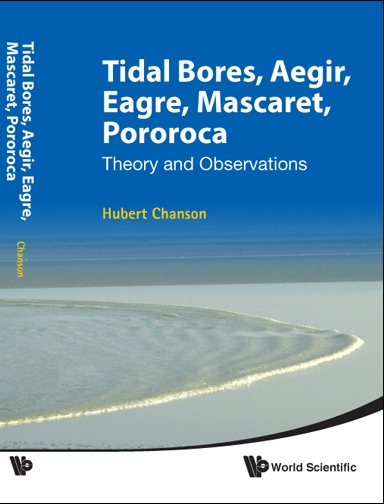 Photographs
courtesy of Sequana-Normandie (Caudebec-en-Caux, France), Jean-Jacques
MALANDAIN, Dr Eric JONES, Professor Howell PEREGRINE, Petitcodiac
Riverkeeper.
Photographs
courtesy of Sequana-Normandie (Caudebec-en-Caux, France), Jean-Jacques
MALANDAIN, Dr Eric JONES, Professor Howell PEREGRINE, Petitcodiac
Riverkeeper.
License

This work is licensed under a Creative
Commons Attribution-NonCommercial 3.0 Unported License.
Hubert
CHANSON is a Professor in Civil Engineering, Hydraulic Engineering
and Environmental Fluid Mechanics at the University
of Queensland, Australia. His research interests include design of
hydraulic structures, experimental investigations of two-phase flows,
applied hydrodynamics, hydraulic engineering, water quality modelling,
environmental fluid mechanics, estuarine processes and natural resources.
He has been an active consultant for both governmental agencies and
private organisations. His publication record includes over 950
international refereed papers and his work was cited over 6,000 times
(WoS) to 21,500 times (Google
Scholar) since 1990. His h-index is 42 (WoS), 45 (Scopus) and 72 (Google
Scholar), and he is ranked among the 150 most cited researchers in
civil engineering in Shanghai’s
Global Ranking of Academics. Hubert Chanson is the author of twenty
books, including "Hydraulic Design
of Stepped Cascades, Channels, Weirs and Spillways" (Pergamon,
1995), "Air Bubble Entrainment in
Free-Surface Turbulent Shear Flows" (Academic
Press, 1997), "The Hydraulics
of Open Channel Flow : An Introduction" (Butterworth-Heinemann,
1st edition 1999, 2nd
editon 2004), "The Hydraulics of
Stepped Chutes and Spillways" (Balkema,
2001), "Environmental
Hydraulics of Open Channel Flows" (Butterworth-Heinemann,
2004), "Tidal
Bores, Aegir, Eagre, Mascaret, Pororoca: Theory And Observations" (World
Scientific, 2011) and "Applied
Hydrodynamics:
an Introduction" (CRC
Press, 2014). He co-authored three further books "Fluid Mechanics
for Ecologists" (IPC Press, 2002), "Fluid Mechanics for Ecologists.
Student Edition" (IPC, 2006) and
"Fish Swimming in Turbulent Waters. Hydraulics Guidelines
to assist Upstream Fish Passage in Box Culverts" (CRC Press 2021). His textbook "The Hydraulics
of Open Channel Flows : An Introduction" has already been translated
into Spanish (McGraw-Hill
Interamericana) and Chinese (Hydrology Bureau of Yellow
River Conservancy Committee), and the second
edition was published in 2004. In 2003, the IAHR
presented him with the 13th Arthur Ippen Award
for outstanding achievements in hydraulic engineering. The American
Society of Civil Engineers, Environmental and Water Resources Institute
(ASCE-EWRI) presented him with the 2004 award for the Best Practice paper
in the Journal of Irrigation and Drainage Engineering ("Energy
Dissipation
and Air Entrainment in Stepped Storm Waterway" by Chanson and
Toombes 2002) and the 2018 Honorable Mention Paper Award for "Minimum Specific
Energy and Transcritical Flow in Unsteady Open-Channel Flow" by
Castro-Orgaz and Chanson (2016) in the ASCE Journal of Irrigation and
Drainage Engineering. The Institution of Civil Engineers (UK) presented
him the 2018 Baker Medal. In 2018, he was inducted a Fellow of the Australasian Fluid Mechanics Society.
Hubert Chanson edited further several books : "Fluvial,
Environmental and Coastal Developments in Hydraulic Engineering"
(Mossa, Yasuda & Chanson 2004, Balkema),
"Hydraulics.
The
Next Wave" (Chanson & Macintosh 2004, Engineers
Australia), "Hydraulic
Structures:
a Challenge to Engineers and Researchers" (Matos & Chanson 2006,
The University of Queensland), "Experiences and
Challenges in Sewers: Measurements and Hydrodynamics" (Larrate &
Chanson 2008, The University of
Queensland), "Hydraulic
Structures:
Useful Water Harvesting Systems or Relics?" (Janssen & Chanson
2010, The University of Queensland),
"Balance
and Uncertainty: Water in a Changing World" (Valentine et al. 2011,
Engineers Australia), "Hydraulic
Structures and Society – Engineering Challenges and Extremes"
(Chanson and Toombes 2014, University
of Queensland), "Energy
Dissipation
in Hydraulic Structures" (Chanson 2015, IAHR
Monograph, CRC Press). He chaired the Organisation of the 34th
IAHR World Congress held in Brisbane, Australia between 26 June and
1 July 2011. He chaired the Scientific Committee of the 5th IAHR
International Symposium on Hydraulic Structures held in Brisbane in
June 2014. He chaired the Organisation of the 22nd Australasian Fluid
Mechanics Conference held as a hybrid format in Brisbane, Australia on
6-10 December 2020.
His Internet home page is http://www.uq.edu.au/~e2hchans.
He also developed a gallery of photographs website {http://www.uq.edu.au/~e2hchans/photo.html}
that received more than 2,000 hits per month since inception.
More about tidal bores
... More pictures of tidal bores are here.
TECHNICAL INTERNET RESOURCES
More about Rubber dams ...
More about Timber crib weirs
... More on Steel dams
...
More about Air entrainment on chutes spillways
... More about a History
of
arch dams ....
Minimum Energy
Loss culverts and bridge waterways ... More
about Minimum
Energy Loss (MEL) weir design ...
More about the Formal Water Garden
.... More about rapid
reservoir sedimentation in Australia ...
This page was visited : 26,125 times between
05-01-2000 and June 2012.
Last updated on 02/08/2021
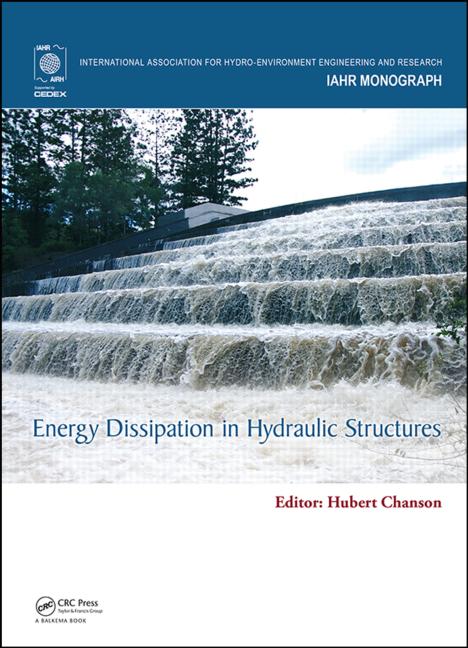


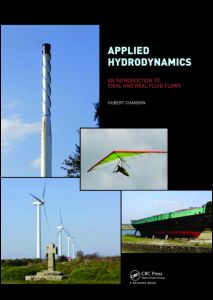

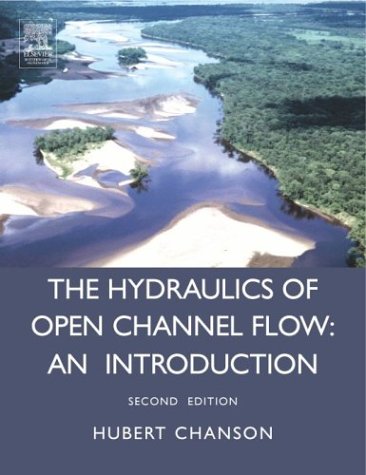
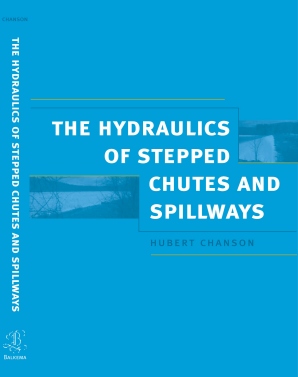
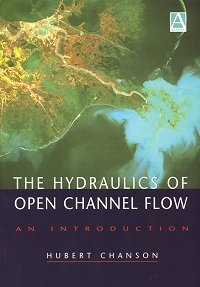


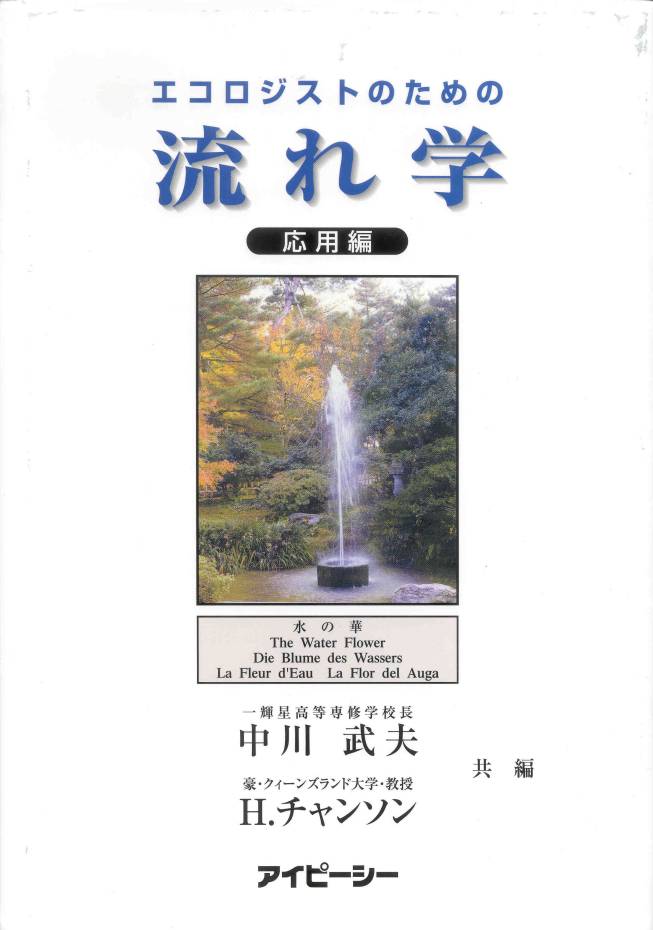

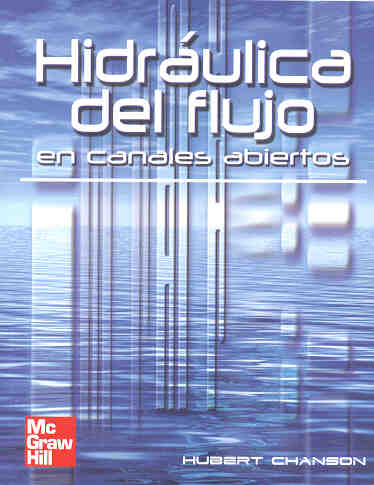
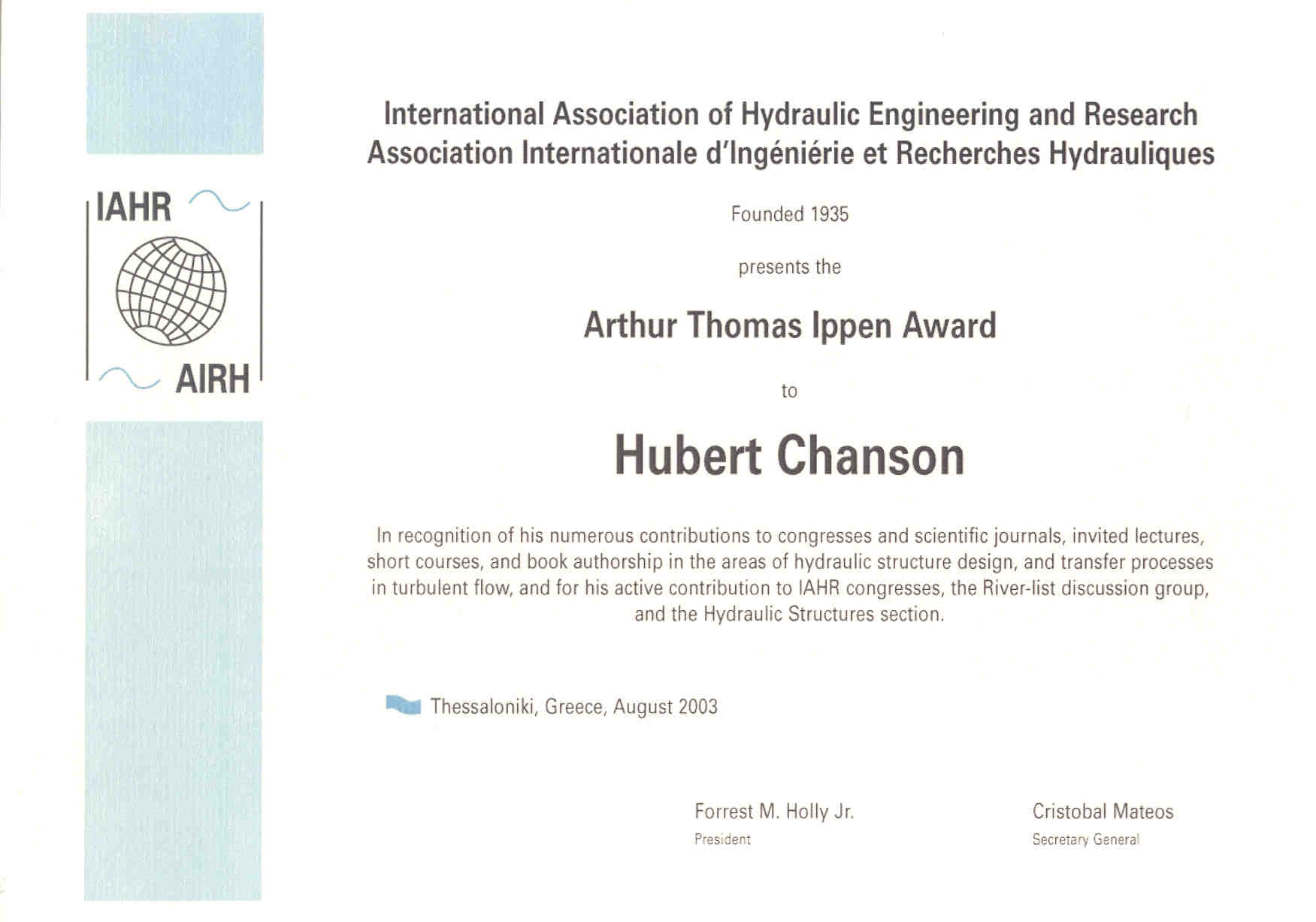

 A bore is a positive surge (1)
of tidal origin. Tidal bores occur as the tidal flow turns to rising (e.g. TRICKER 1965, CHANSON 1999).
Famous ones include the Hangchow (or
Hangzhou) bore on the Qiantang river, the Amazon bore called pororoca,
the tidal bore on the Seine river, the Hoogly (or Hooghly) bore on the
Gange, the bore on the Mekong river. Smaller tidal bores occur on the Severn
river near Gloucester, England, on the Trent river (aegir), on
the Garonne and Dordogne rivers,
France, at Turnagain Arm and Knik Arm, Cook Inlet (Alaska), the bores in the
Bay of Fundy (New Brunswick, Nova Scotia) like at Petitcodiac,
tidal bores on the Styx river QLD and on the Daly river NT (Australia), the
tidal bore called benak at Batang
Lupar (Malaysia) (CHANSON 2001,2005).
A bore is a positive surge (1)
of tidal origin. Tidal bores occur as the tidal flow turns to rising (e.g. TRICKER 1965, CHANSON 1999).
Famous ones include the Hangchow (or
Hangzhou) bore on the Qiantang river, the Amazon bore called pororoca,
the tidal bore on the Seine river, the Hoogly (or Hooghly) bore on the
Gange, the bore on the Mekong river. Smaller tidal bores occur on the Severn
river near Gloucester, England, on the Trent river (aegir), on
the Garonne and Dordogne rivers,
France, at Turnagain Arm and Knik Arm, Cook Inlet (Alaska), the bores in the
Bay of Fundy (New Brunswick, Nova Scotia) like at Petitcodiac,
tidal bores on the Styx river QLD and on the Daly river NT (Australia), the
tidal bore called benak at Batang
Lupar (Malaysia) (CHANSON 2001,2005).

 The tidal bore on
the Qiantang River near Hangzhou, China, also known as the
Hangchow or Hangzou bore: Photo
No.1: Qiantang River bore at Hangzhou CBD City Balcony on 9 October
2014. Photo No.2:
tidal bore at Qilimiao downstream of Yanguan on 11 October 2014. Photo No. 3: tidal bore between
Yanguan and Laoyanchang on 11 October 2014. Photo
No. 4: breaking tidal bore and roller between between Yanguan and
Laoyanchang on 11 October 2011. Photo
No.
5: tidal bore reflection at Laoyanchang on 11 October 2011. Photo No. 6 : tidal bore impact on
sluice gate structure at Jiuxi on 11 October 2014; in the foreground, the
reflected wave overtopped the river bank, flooding the nearby arterial and
causing some traffic accident and traffic jam. Photo
No. 7: tidal bore at Meilvba overtopping a spur dyke on 12 October
2014. Photo No. 8:
tidal bore impact on the sea wall at Xinchang on 13 October 2014; the bore
was reflected on the wall and the reflection came back about 40 minutes
later. Photo No. 9:
tidal bore warning sign at Meilvba in October 2014; in this area, the
embankent dyke is regularly overtopped. Photo
No. 11 : view from the left bank (Courtesy of Dr J. Eric JONES); Photo No. 12 : another detailed view
(Courtesy of Dr J. Eric JONES).
The tidal bore on
the Qiantang River near Hangzhou, China, also known as the
Hangchow or Hangzou bore: Photo
No.1: Qiantang River bore at Hangzhou CBD City Balcony on 9 October
2014. Photo No.2:
tidal bore at Qilimiao downstream of Yanguan on 11 October 2014. Photo No. 3: tidal bore between
Yanguan and Laoyanchang on 11 October 2014. Photo
No. 4: breaking tidal bore and roller between between Yanguan and
Laoyanchang on 11 October 2011. Photo
No.
5: tidal bore reflection at Laoyanchang on 11 October 2011. Photo No. 6 : tidal bore impact on
sluice gate structure at Jiuxi on 11 October 2014; in the foreground, the
reflected wave overtopped the river bank, flooding the nearby arterial and
causing some traffic accident and traffic jam. Photo
No. 7: tidal bore at Meilvba overtopping a spur dyke on 12 October
2014. Photo No. 8:
tidal bore impact on the sea wall at Xinchang on 13 October 2014; the bore
was reflected on the wall and the reflection came back about 40 minutes
later. Photo No. 9:
tidal bore warning sign at Meilvba in October 2014; in this area, the
embankent dyke is regularly overtopped. Photo
No. 11 : view from the left bank (Courtesy of Dr J. Eric JONES); Photo No. 12 : another detailed view
(Courtesy of Dr J. Eric JONES).  Photographs
courtesy of Sequana-Normandie (Caudebec-en-Caux, France), Jean-Jacques
MALANDAIN, Dr Eric JONES, Professor Howell PEREGRINE, Petitcodiac
Riverkeeper.
Photographs
courtesy of Sequana-Normandie (Caudebec-en-Caux, France), Jean-Jacques
MALANDAIN, Dr Eric JONES, Professor Howell PEREGRINE, Petitcodiac
Riverkeeper.













